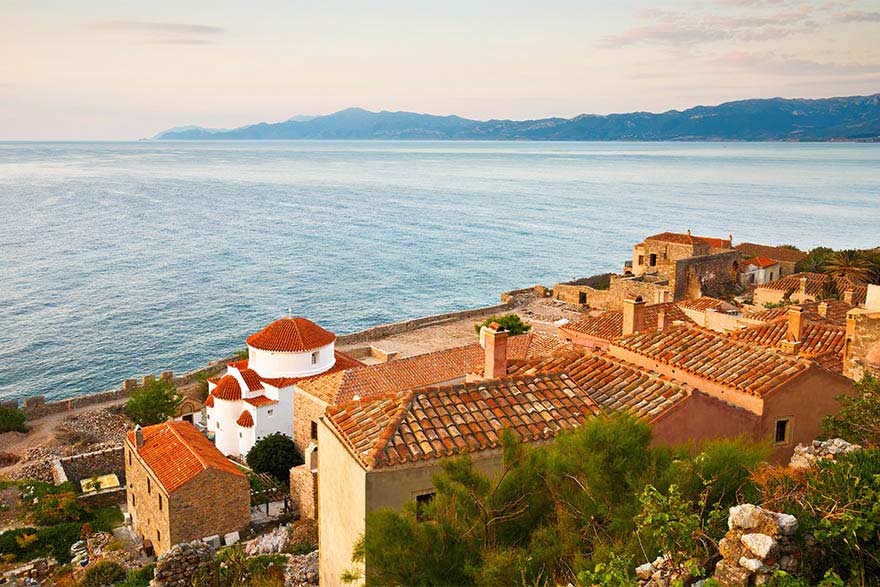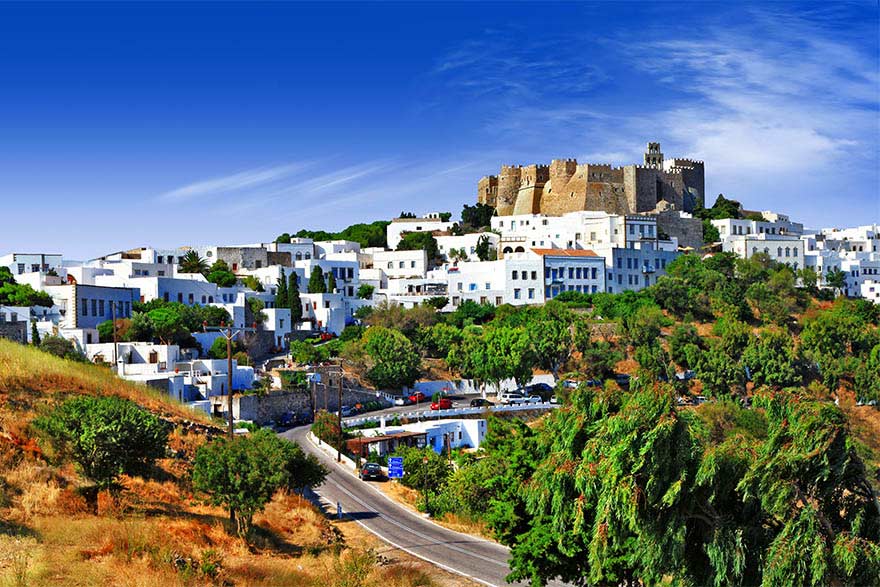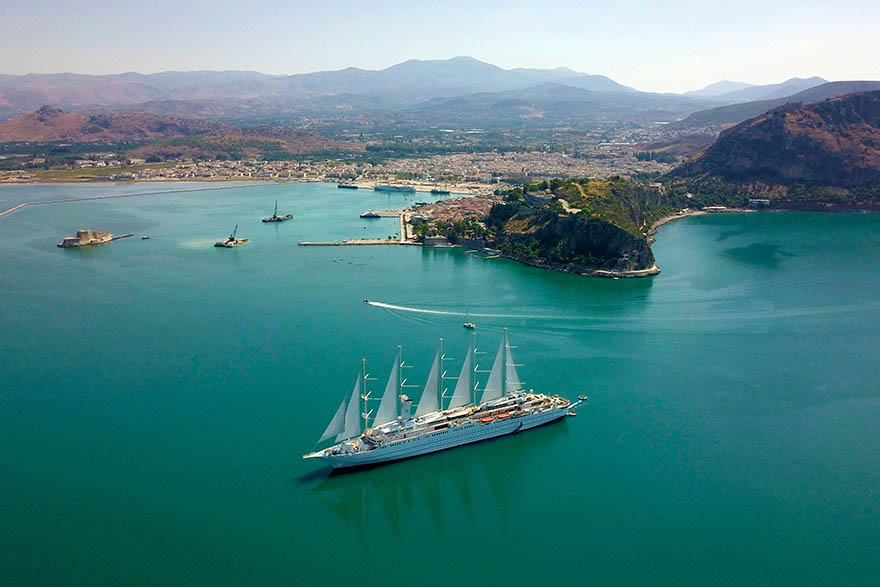Windstar’s yachts anchor in smaller, secluded ports in the Mediterranean, offering access to an endless number of hidden gems in Greece. Visit the ancient city of Nafplio, which was first inhabited during the Mycenaean period, bask in the sun on Crete’s stunning beaches, or wander into the depths of the Zas Cave, which is said to be the birthplace of Zeus.
Whether you are sampling fresh fare at a seaside café or marveling at medieval castles, these are our favorite small ports in Greece:
Monemvasia

When you wander along the narrow cobblestone streets of Monemvasia, you may feel like you have stepped into a fairy tale. Monemvasia means “single entrance,” and the tiny island is only accessible via a short bridge connected to the Peloponnese peninsula, just north of the marina. The fortress town was established by the Byzantines in the sixth century, and to avoid enemy attacks, the sprawling castle was built on the south side of the island, out of sight from the mainland.
The town’s lower section features a labyrinth of pedestrian-only streets surrounded by beautifully restored stone mansions, plus the Church of Christ Elkomenos, which dates to the 13th century. The town’s uninhabited upper section is home to the Fortress of Youlás and the Church of Agia Sofia, both of which offer stunning views of Palaia Monemvasia bay and beyond. The church was originally established in the 12th century by the Byzantine emperor Andronicus II, making it one of the oldest Byzantine churches in Greece.
Patmos

Patmos is most famous for the Monastery of St. John, which resembles a castle and sits high above Chora, the island’s capital. (Chora means town in Greek, and it is used to denote the capital on a handful of other islands.) Chora has a classic Greek aesthetic with narrow streets and clusters of whitewashed buildings, plus spectacular views of the Aegean Sea. The nearby Simandris House has an extensive collection of antiques and architecture, and the nearby city of Skala offers a wealth of shops, bars and seaside cafes. For those interested in basking in the sun and going for a swim, Patmos has several beaches, including Agriolivado, Kambos and Livadi Geranou.
Built-in the 11th century, the Monastery of St. John contains eight chapels and an exquisitely beautiful courtyard inside the massive walls and battlements. The museum houses a magnificent collection of jeweled chalices, crowns and crosses, plus several religious paintings, including an original El Greco. Another top attraction is the Grotto of St. John, a 17th-century monastery built around the cave where St. John of Patmos lived when he received the visions recorded in the Book of Revelation.
Nafplio

Upon arrival in Nafplio, you will immediately notice the spectacular Bourtzi Castle, which appears to float on the water next to the coastal city. The fortress was built in 1473 on the neighboring islet of St. Theodoro, but Nafplio’s history can be traced back to ancient times. First inhabited during the Mycenaean period (from approximately 1750 BC to 1050 BC), the city was destroyed by the king of Argos in 685 BC after the second Messenian War. Following centuries of decline, Nafplio once again flourished under the rule of Byzantine Empire, which ran from approximately 330 AD to 1453 AD.
Nafplio is the gateway town to some of the most incredible historical sites in Europe, including the famous Theater of Epidaurus, which is widely regarded as the best-preserved ancient Greek theater in the world. Famous for its superb acoustics, the theater was built in the 4th century BC and had a capacity of about 12,000 spectators. The nearby ruins of Mycenae and Tiryns were once the sites of the two greatest cities of the Mycenaean civilization, and they played a key role in the development of classical Greek culture.
The Peloponnese wine region is also notable for being one of the most viticulturally productive areas in Greece, and you will have the opportunity to visit two of the top vineyards, the Gofas Winery and the Semeli Estate.
Ermoupoli (Syros)

Ermoupoli is the capital of Syros, and the port city also serves as the administrative capital for the Cyclades islands. The city’s pastel neoclassical buildings create a stunning contrast between the blue waters of the Aegean Sea, and the countryside is dotted with farms and olive groves.
Miaouli Square features marble streets lined with palm trees, and the adjacent Town Hall is equally impressive. The Town Hall was built in 1876, and it features a three-story facade displaying three different architectural styles. The Town Hall also houses the Archaeological Museum, which is one of the oldest museums in Greece. The nearby Apollo Theater, which was built in 1864 and inspired by Milan’s La Scala theater, is also worth a visit. Just a few minutes from the theater is the Agios Nikolaos Church, which is one of the most recognizable landmarks in the city and one of the country’s largest churches. The church was completed in 1870, and its interior is just as elaborate as the colorful exterior, with gilt detailing, frescoes, a marble pulpit and crystal chandeliers.
Naxos

One of Windstar’s relatively new ports here, the island of Naxos is a hidden gem in the heart of the Cyclades islands. Though it is close to touristy hotspots like Santorini and Mykonos, Naxos is still relatively unknown, appealing to history buffs and nature lovers alike.
Portara, also known as the Temple of Apollo or the Great Door, is indisputably Naxos’ most photographed landmark. The massive marble doorway, which was erected in the 6th century BC, is located near the port on the Palatia Islet. The island’s main town of Chora features a number of palaces dating back to the island’s Venetian Period, including the Glezos-Crispi Tower, which is the last remaining tower of the nearly one dozen that once existed at Naxos Castle.
The island has a remarkably diverse landscape, with everything from mountain biking trails to pristine beaches. At 3,290 feet (1,003 meters), Mt. Zas is the highest mountain in the Cyclades islands, and the route to the summit offers a stop at the Zas Cave. Not only does the cave have fantastic displays of stalactites and stalagmites, but according to Greek mythology, Zeus spent some of his childhood here. The coastline of Naxos is home to several gorgeous beaches, including Aliko, Plaka and Agios Prokopios, all of which feature golden sand and vibrant blue aqua water reminiscent of the Caribbean.
Agios Nikolaos (Crete)

Crete’s darling port town of Agios Nikolaos is set around the tranquil waters of Lake Voulismeni, which is surrounded by open-air cafes and rocky cliffs. During the day, it’s the perfect spot to take a stroll, pursue the local markets and enjoy fresh local fare, and at night the lake comes alive when the bars light up along the water.
Just ten kilometers west of the port city is the charming village of Kritsa, set at the base of Mt. Kastellosviews. From the views of Mirabello Bay to the whitewashed houses built into a hillside, Krista is the quintessential Greek village. The nearby church of Panagia Kera dates back to the 13th century, and it is notable for having one of the best-preserved Byzantine frescoes on the island.
For those looking to lounge in the sun, there are a handful of gorgeous beaches just 15 minutes from the port. The beaches at Almyros, Voulisma and Karavostassi all boast white sands and turquoise waters, with cafes close by for refreshments. For a cooler adventure, explore the depths of the Dictaean Cave, which is believed to be the birthplace of Zeus, the king of gods. In addition to massive stalagmites and stalactites, the large cave has five lower chambers, one of which features a small lake.





